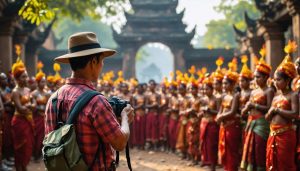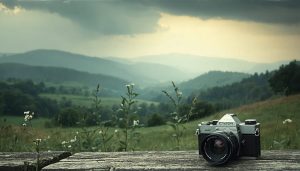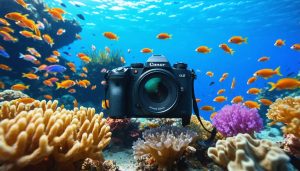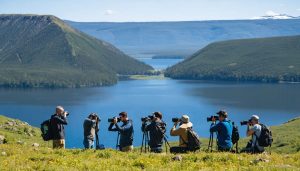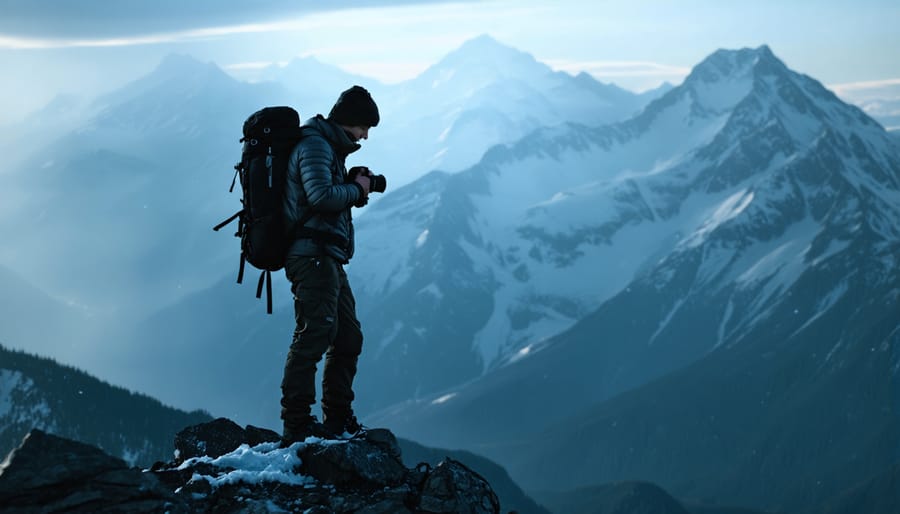
Capturing breathtaking moments in the wilderness demands gear that’s as rugged as your adventures. When your camera becomes your lifeline to immortalizing split-second wildlife encounters, scaling mountain peaks, or diving into underwater caves, every piece of equipment must balance durability with performance. Adventure photography pushes both photographer and gear to their limits, requiring a carefully curated kit that withstands extreme conditions while delivering professional results. From weather-sealed cameras that brave sandstorms to shock-resistant storage solutions that protect your precious images, the right adventure photography gear transforms challenging environments into opportunities for extraordinary shots. Whether you’re documenting expeditions in the Arctic or capturing action sports in desert canyons, this guide will equip you with essential knowledge about selecting, protecting, and maintaining gear that performs when every shot counts.
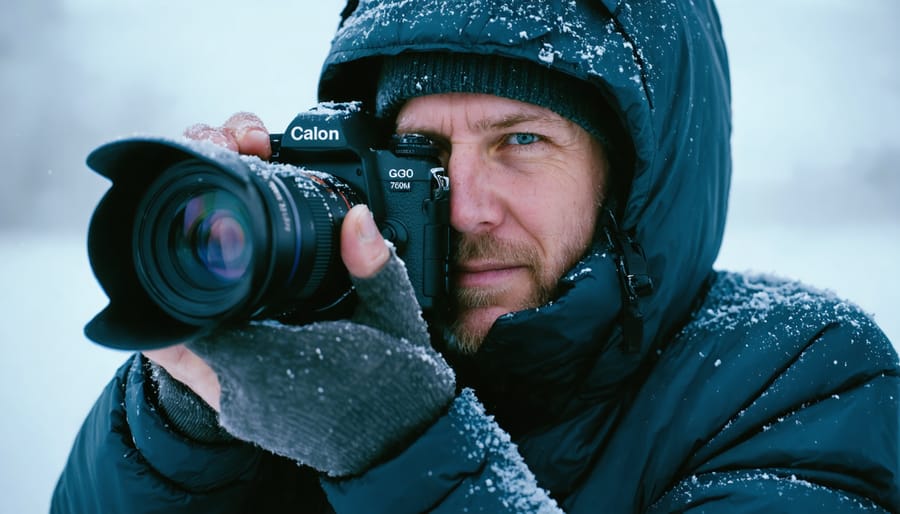
Weather-Sealed Camera Bodies Worth Their Weight
Professional vs. Weather-Resistant Options
When venturing into extreme weather photography, choosing between professional and weather-resistant cameras can significantly impact both your images and wallet. Professional-grade cameras like the Canon EOS R5 or Nikon Z9 offer superior weather sealing with robust magnesium alloy bodies, ensuring protection against moisture, dust, and freezing temperatures. These high-end models typically feature more extensive weather sealing around buttons, dials, and card slots, making them ideal for harsh conditions.
However, mid-range options like the Olympus OM-D E-M5 Mark III or Pentax K-3 III offer impressive weather resistance at a more accessible price point. These cameras incorporate similar sealing techniques to their professional counterparts, often providing adequate protection for most adventure scenarios. The key difference lies in their construction materials and the extent of weatherproofing.
When choosing between these options, consider your typical shooting conditions and frequency of exposure to challenging environments. Professional bodies excel in sustained harsh conditions, while weather-resistant alternatives perform admirably in occasional adverse weather. Remember that weather resistance isn’t just about the camera body – matching it with similarly protected lenses is crucial for a truly weatherproof system.
For most enthusiasts, a well-maintained weather-resistant camera will suffice, while professionals who regularly shoot in challenging conditions should invest in pro-grade equipment. Either way, always use additional protection like rain covers for extra security in severe weather.
Key Features for Harsh Environments
When venturing into challenging environments, your camera needs to be as tough as your adventurous spirit. Weather sealing is non-negotiable – look for cameras with robust magnesium alloy bodies and comprehensive sealing against moisture, dust, and freezing temperatures. Today’s innovative camera features include enhanced image stabilization systems that can handle shooting from moving vehicles or unstable platforms.
Battery performance in extreme temperatures is crucial, so opt for cameras with extended battery life and compatibility with battery grips. Modern camera automation features like intelligent subject tracking and rapid autofocus are particularly valuable when capturing fast-moving subjects in challenging conditions.
Look for cameras with dual memory card slots for backup security – you don’t want to lose those once-in-a-lifetime shots due to card failure. High ISO performance is essential for low-light scenarios, while a bright, clear electronic viewfinder helps maintain composition in harsh sunlight.
Durability extends to the physical controls too – ensure buttons and dials are easily operational with gloves on. Some cameras now feature voice control options, which can be invaluable when your hands are occupied with climbing gear or when wearing thick gloves. Built-in GPS for location tagging and wireless connectivity for backup can also prove invaluable in remote locations.
Rugged Lenses That Keep Shooting
All-In-One vs. Prime Lenses for Adventure
When heading into the wilderness, the choice between all-in-one zoom lenses and prime lenses can significantly impact both your pack weight and shooting capabilities. All-in-one lenses, typically offering ranges like 24-70mm or 28-300mm, provide versatility that’s hard to beat when you’re scaling a mountain or trekking through remote locations. They eliminate the need for constant lens changes, which is particularly valuable in dusty or wet conditions.
However, prime lenses have their distinct advantages. Their wider maximum apertures (often f/1.8 or f/1.4) excel in low-light situations, like capturing starlit landscapes or dawn summit attempts. They’re generally sharper than zoom lenses and produce superior bokeh, perfect for isolating subjects against dramatic backgrounds.
For day hikes and accessible locations, carrying multiple prime lenses might be feasible. A typical prime kit might include a 24mm for landscapes, 50mm for general use, and 85mm for details and portraits. But for extended backcountry trips or technical climbs, a high-quality all-in-one zoom often proves more practical.
Consider your specific adventure type when choosing. Rock climbing? A single zoom lens means fewer items to secure. Multi-day hiking? Perhaps pack both a versatile zoom and your favorite prime for camp scenes. Photography in extreme conditions often requires compromising between ideal image quality and practical considerations.
Essential Lens Protection Systems
When venturing into challenging environments, protecting your valuable lenses becomes just as crucial as selecting the right essential camera accessories. A robust lens protection system starts with high-quality UV filters, which act as a sacrificial shield against dust, moisture, and unexpected impacts. While some photographers debate their necessity, in adventure photography, they’re non-negotiable.
Clear or neutral density filters are vital when shooting in extreme conditions. Consider investing in a circular polarizing filter to manage reflections and enhance colors, particularly useful when photographing water features or through glass. Multi-coated filters offer superior protection against lens flare and ghosting while maintaining image quality.
For those shooting in wet conditions, hydrophobic coating treatments can be game-changing. These specialized coatings repel water droplets, ensuring clearer shots in rain or spray. Pair these with rubber lens hoods, which provide additional protection against bumps and stray light while being more durable than plastic alternatives.
Don’t overlook lens caps and rear caps – opt for secure-fitting professional-grade options rather than standard ones. A good tip is to carry spare caps, as they’re often the first items to go missing during adventure shoots. For extreme environments, consider using clear protective filters with gaskets that create a weather-sealed barrier between your lens and the elements.
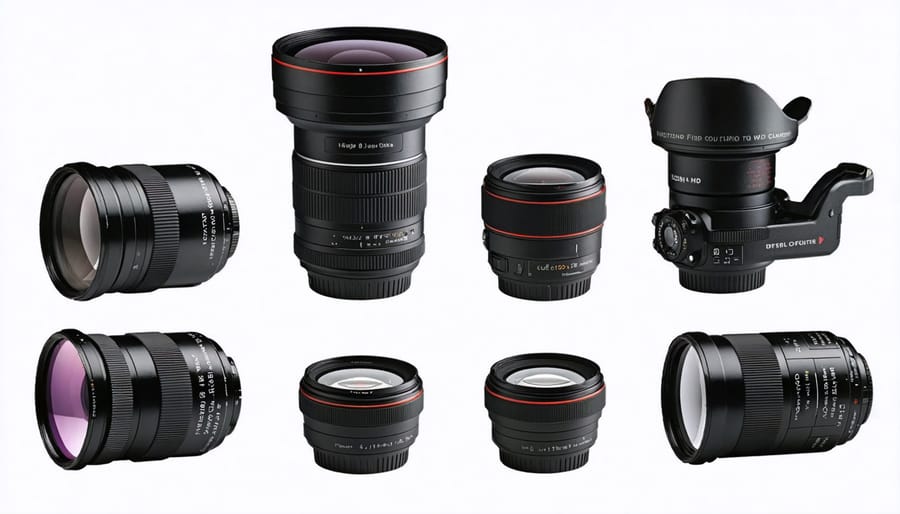
Innovative Carrying Solutions
Quick-Access Adventure Packs
Modern adventure photography backpacks have revolutionized how we carry and access our gear in the field. The latest innovations focus on quick-access designs that let you grab your camera without removing the pack – essential when those perfect moments arise unexpectedly.
Leading the charge are side-access systems, which feature dedicated camera compartments accessible from both sides of the pack. This design proves invaluable when implementing advanced shooting techniques in challenging terrain, allowing you to swap lenses or grab filters without setting your pack down.
Weather-resistant materials now come standard, with manufacturers incorporating ripstop nylon and water-sealed zippers. Many packs feature modular internal dividers that can be customized based on your kit size and shooting needs. The newest models also include dedicated drone compartments and laptop sleeves, reflecting the evolving needs of modern adventure photographers.
Comfort hasn’t been overlooked either. Ventilated back panels, load-distributing harness systems, and adjustable torso lengths ensure you can carry heavy gear comfortably during long hikes. Some packs even feature removable camera cubes, transforming them into regular daypacks when needed.
Look for packs with multiple attachment points for tripods, trekking poles, and other accessories. These external carrying options help balance weight distribution while keeping essential tools within reach.
Harness Systems and Clips
When you’re scrambling over rocks or navigating tricky terrain, having your hands free while keeping your camera accessible is crucial. This is where a well-designed harness system becomes invaluable for adventure photographers. The most popular options include chest harnesses, which keep your camera centered and stable while hiking, and holster-style systems that attach to your backpack straps or belt.
Peak Design’s Capture Clip has become something of an industry standard, allowing you to securely attach your camera to any strap or belt, while providing instant access when that perfect shot presents itself. For those carrying multiple bodies, dual-camera harnesses distribute weight evenly across your shoulders, preventing neck strain during long shoots.
Don’t overlook the importance of quality clips and quick-release mechanisms. Look for weather-sealed aluminum or reinforced plastic components that can withstand dust, moisture, and repeated use. Cotton Carrier and Spider Holster systems offer robust alternatives with their own unique mounting solutions.
For extreme activities like rock climbing or skiing, consider adding backup tethers to your harness system. These provide additional security should your primary attachment fail. Many photographers combine a chest harness with a peak-design clip as a redundant system, ensuring their gear stays safe even in the most challenging conditions.
Remember to test your harness setup thoroughly in a controlled environment before heading out on location. This helps you develop muscle memory for quick access and ensures all components work together seamlessly.
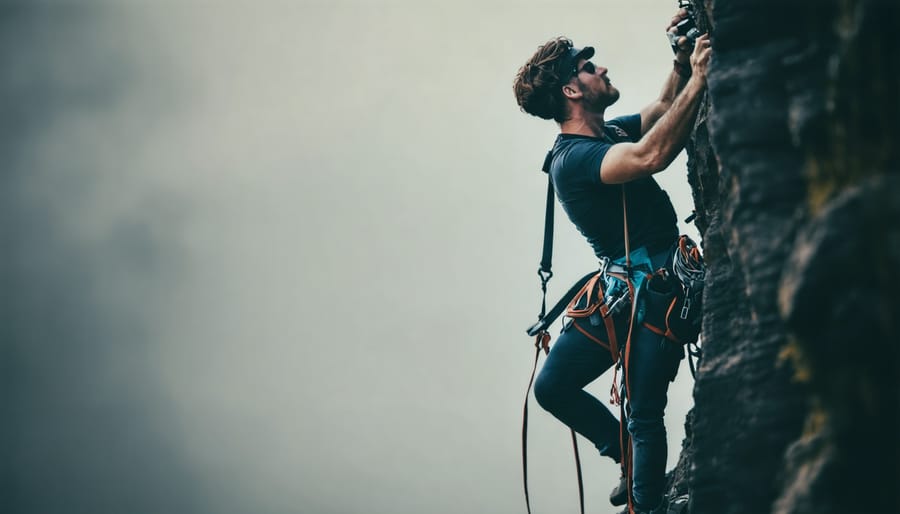
Power and Storage in the Wild
Rugged Power Banks and Solar Options
When you’re out capturing nature’s wonders, keeping your gear powered up is crucial. Modern power banks designed for outdoor use are built like tanks, featuring rubber armor, waterproof construction, and shock resistance. Look for models with at least 20,000mAh capacity, which can recharge a mirrorless camera 4-5 times or keep your phone running for days.
The Goal Zero Sherpa 100PD and Anker PowerCore+ 26800 are standout options, offering multiple ports and reliable performance in harsh conditions. Both feature fast-charging capabilities and can handle temperature extremes without losing efficiency.
For extended trips, combining a rugged power bank with a portable solar panel creates a sustainable power solution. Foldable solar panels like the BigBlue 28W and Goal Zero Nomad 20 are lightweight yet efficient, capable of charging your power bank or devices directly in good sunlight. Position them on your backpack while hiking or set them up at camp to harvest energy throughout the day.
Pro tip: Always carry at least two power banks and keep them in different bags. This redundancy has saved many photographers when one bank fails or gets damaged. Also, consider power banks with built-in LED lights – they serve double duty as emergency lighting when setting up camp or during pre-dawn shoots.
Weatherproof Storage Solutions
When you’re capturing stunning shots in challenging environments, protecting your precious image files is just as crucial as getting the shot itself. Professional-grade memory cards with weather-sealing and temperature resistance are your first line of defense. Look for cards rated for extreme temperatures (-13°F to 185°F) and featuring water-resistant construction.
Don’t put all your eggs in one basket – use multiple smaller capacity cards rather than a single large one. This strategy minimizes potential data loss if a card fails. For extended trips, portable backup drives designed for outdoor use are essential. Models like the LaCie Rugged series or G-Technology ArmorATD feature rubber bumpers, water resistance, and shock protection up to 4-foot drops.
Consider a wireless backup solution that automatically transfers images to your phone or tablet when shooting. This provides an immediate backup without handling cards in challenging conditions. For arctic or desert environments, store memory cards in a silica-gel equipped, waterproof case to protect against moisture and temperature fluctuations.
Keep your backup routine simple but consistent. At day’s end, transfer images to at least two separate devices. One photographer’s mantra worth adopting: “If it doesn’t exist in three places, it doesn’t exist at all.” Power banks with weather sealing are also crucial for keeping your backup devices running in remote locations.
Remember to test your backup system before heading out – you don’t want to discover issues when you’re already in the field.
Emergency Gear and Maintenance Tools
Field Repair Kit Essentials
When you’re miles from civilization, a well-stocked repair kit can mean the difference between capturing that perfect shot and heading home empty-handed. Start with the basics: a multi-tool with pliers and screwdrivers is essential for tightening loose components or making quick adjustments to your tripod. Include a set of precision screwdrivers specifically sized for camera body and lens repairs.
Gaffer tape is your best friend in the field – it’s stronger than duct tape and doesn’t leave residue. Pack a small roll wrapped around a pencil to save space. Keep several microfiber cloths for cleaning lenses and sensors, along with a rocket blower and lens cleaning solution in a leak-proof container.
Don’t forget spare parts: extra body cap, lens caps, and hot shoe cover. These small items frequently go missing and can leave sensitive components exposed. Include a handful of zip ties, which can temporarily fix broken camera straps or secure loose equipment. A small tube of super glue can repair minor cracks in non-optical equipment.
For electronic essentials, pack spare batteries and memory cards in a waterproof case. Include a small roll of electrical tape and wire strippers – you never know when you’ll need to fix a frayed cable. A simple rain cover made from a plastic bag can be a lifesaver, so pack a few heavy-duty ones.
Finally, add a small notebook and permanent marker. Document any repairs you make in the field – this information will be invaluable for proper repairs once you’re back home. Keep everything organized in a water-resistant pouch, and always check your kit before heading out on a new adventure.
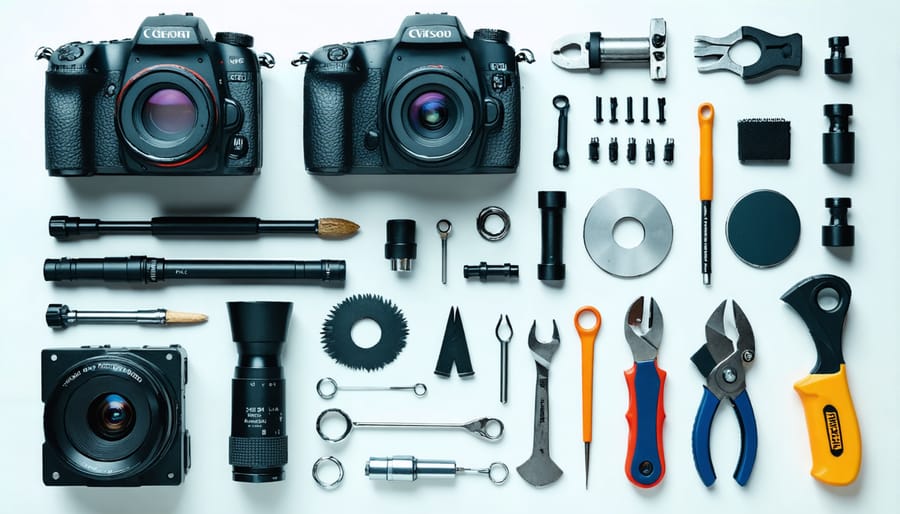
Moisture Control and Cleaning
Moisture and dirt are two of adventure photography’s biggest enemies, but with the right approach, you can keep your gear safe and functional in challenging conditions. Start with a collection of high-quality silica gel packets in your camera bag – they’re inexpensive yet incredibly effective at managing humidity. For added protection, consider using weather-sealed dry bags, particularly when shooting near waterfalls or during unpredictable weather.
A basic cleaning kit is essential for field maintenance. Pack a rocket blower, lens cleaning solution, microfiber cloths, and lens cleaning wipes. The rocket blower should be your first line of defense – use it regularly to remove loose dirt and sand before they can scratch your equipment. When cleaning lenses, always start with the blower before moving to gentler wiping motions with a microfiber cloth.
In extremely humid environments, consider using a portable dehumidifier in your hotel room or tent to dry out gear overnight. A simple yet effective trick is to store your camera and lenses in a sealed plastic bag when moving from cold to warm environments, allowing condensation to form on the bag rather than your equipment.
For water-based adventures, invest in good-quality rain covers or underwater housings depending on your needs. Even weather-sealed cameras benefit from additional protection in heavy rain or spray. After exposure to salt water or sand, wipe down your gear with a slightly damp cloth, followed by a dry one, paying special attention to buttons and dials where salt can accumulate.
Remember to clean your filters and lens caps too – they’re often overlooked but can transfer dirt directly to your glass if neglected.
Adventure photography requires careful consideration of your gear choices, and as we’ve explored throughout this article, having the right equipment can make the difference between capturing that perfect shot and missing the moment entirely. Remember that while high-end gear can enhance your capabilities, even a basic weather-sealed camera and versatile lens can yield amazing results when paired with proper technique and creativity.
The key takeaway is to prioritize durability and versatility in your gear selection. Start with a reliable camera body and a few essential lenses that match your preferred shooting style. Invest in quality protective equipment, including a sturdy camera bag and weather-protective gear. Don’t overlook the importance of backup power solutions and storage options – these can be lifesavers during extended trips.
For those just starting their adventure photography journey, consider beginning with a weather-sealed mirrorless camera and a versatile zoom lens. As you develop your style and face different challenges in the field, gradually expand your kit based on your specific needs and experiences.
Remember that the best gear is the gear that you’ll actually carry and use. There’s no perfect one-size-fits-all solution, so focus on building a kit that balances weight, functionality, and your shooting requirements. Regular maintenance and proper care of your equipment will ensure it serves you well through countless adventures and helps you capture those extraordinary moments in the wild.
















